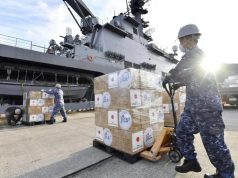
- Shenzhou-15 marks last of 11 missions since April 2021 in building of space station
- Shenzhou-15 crew to take over from Shenzhou-14 astronauts on space station
- Chinese space station to be second permanently inhabited outpost after NASA-led ISS
BEIJING— China sent a spacecraft carrying three astronauts to its space station for the first in-orbit crew rotation in Chinese space history, launching operation of the second inhabited outpost in low-Earth orbit after the NASA-led International Space Station.
The spacecraft Shenzhou-15, or “Divine Vessel”, and its three passengers lifted off atop a Long March-2F rocket from the Jiuquan Satellite Launch Centre at 11:08 p.m. (1508 GMT) on Tuesday amid sub-freezing temperatures in the Gobi Desert in northwest China, according to state television.
Shenzhou-15 was the last of 11 missions, including three prior crewed missions, that began in April 2021 needed to assemble the “Celestial Palace”, as the multi-module station is known in Chinese.
The trio will take over from the Shenzhou-14 crew who arrived in early June. The previous crew members are expected to return to Earth in early December after a one-week handover that will also establish the station’s ability to temporarily sustain six astronauts, another record for China’s space program.
The space outpost took on its current “T” shape in November with the arrival of the last of three cylindrical modules.
The station has a designed lifespan of at least a decade, with resident astronauts expected to conduct over 1,000 scientific experiments – from studying how plants adapt in space to how fluids behave in microgravity.
The “Celestial Palace” was the culmination of nearly two decades of Chinese crewed missions to space. China’s manned space flights began in 2003 when a former fighter pilot, Yang Liwei, was sent into orbit in a small bronze-colored capsule, the Shenzhou-5, and became China’s first man in space and an instant hero cheered by millions at home.
The space station was also an emblem of China’s growing clout and confidence in its space endeavors and a challenger to the United States in the domain, after being isolated from the NASA-led ISS and banned by U.S. law from any collaboration, direct or indirect, with the American space agency.
The Shenzhou-15 mission, during which its crew will live and work on the space station for six months, also offered the nation a rare moment to celebrate, at a time of widespread unhappiness over China’s stifling zero-COVID-19 policies while its economy hits the brakes amid uncertainties at home and abroad.
“Long live the motherland!” many Chinese netizens wrote on social media.
Future ‘Taikonauts’
Leading the Shenzhou-15 mission was Fei Junlong, 57, who hailed from China’s first batch of astronaut trainees in the late 1990s. His previous visit to space was 17 years ago as commander of China’s second-ever crewed spaceflight.
Fei was flanked by Deng Qingming, 56, who had trained for 24 years as an astronaut but had never been chosen for a mission until Shenzhou-15. They were joined by former air force pilot Zhang Lu, 46, also a space debutant.
During the space station’s operation over the next decade, China is expected to launch two crewed missions to the orbiting outpost each year.
The next batch of “taikonauts”, coined from the Chinese word for space, to step foot on the station, in 2023, will be picked from the third generation of astronauts with scientific background. The first and second batches of astronauts in the 1990s-2000s were all former air force pilots.
China has started the selection process for the fourth batch, seeking candidates with doctoral degrees in disciplines from biology, physics and chemistry to biomedical engineering and astronomy.
The selection process has also been opened to applicants from Hong Kong and Macau for the first time.
While still in its infancy compared with NASA‘s technologies and experience, China’s space programme has come far since the mid-20th century when the country’s late leader Mao Zedong lamented that China could not even launch a potato into orbit.
—Reporting by Ryan Woo and Liangping Gao;Editing by Alison Williams and Jonathan Oatis









